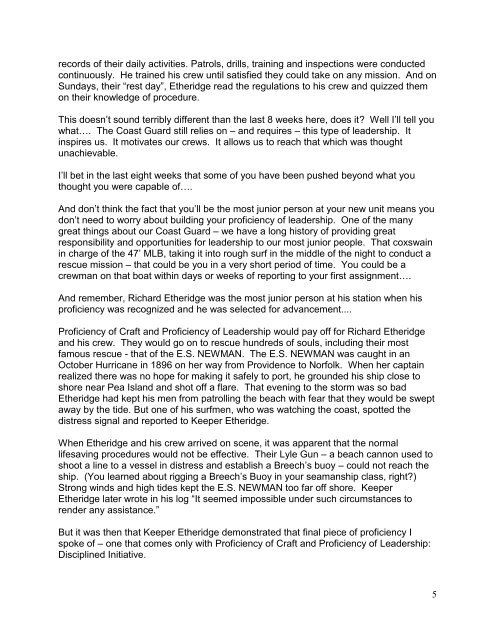Coast Guard Commandant Admiral Bob Papp's ... - U.S. Coast Guard
Coast Guard Commandant Admiral Bob Papp's ... - U.S. Coast Guard
Coast Guard Commandant Admiral Bob Papp's ... - U.S. Coast Guard
Create successful ePaper yourself
Turn your PDF publications into a flip-book with our unique Google optimized e-Paper software.
ecords of their daily activities. Patrols, drills, training and inspections were conducted<br />
continuously. He trained his crew until satisfied they could take on any mission. And on<br />
Sundays, their “rest day”, Etheridge read the regulations to his crew and quizzed them<br />
on their knowledge of procedure.<br />
This doesn’t sound terribly different than the last 8 weeks here, does it? Well I’ll tell you<br />
what…. The <strong>Coast</strong> <strong>Guard</strong> still relies on – and requires – this type of leadership. It<br />
inspires us. It motivates our crews. It allows us to reach that which was thought<br />
unachievable.<br />
I’ll bet in the last eight weeks that some of you have been pushed beyond what you<br />
thought you were capable of….<br />
And don’t think the fact that you’ll be the most junior person at your new unit means you<br />
don’t need to worry about building your proficiency of leadership. One of the many<br />
great things about our <strong>Coast</strong> <strong>Guard</strong> – we have a long history of providing great<br />
responsibility and opportunities for leadership to our most junior people. That coxswain<br />
in charge of the 47’ MLB, taking it into rough surf in the middle of the night to conduct a<br />
rescue mission – that could be you in a very short period of time. You could be a<br />
crewman on that boat within days or weeks of reporting to your first assignment….<br />
And remember, Richard Etheridge was the most junior person at his station when his<br />
proficiency was recognized and he was selected for advancement....<br />
Proficiency of Craft and Proficiency of Leadership would pay off for Richard Etheridge<br />
and his crew. They would go on to rescue hundreds of souls, including their most<br />
famous rescue - that of the E.S. NEWMAN. The E.S. NEWMAN was caught in an<br />
October Hurricane in 1896 on her way from Providence to Norfolk. When her captain<br />
realized there was no hope for making it safely to port, he grounded his ship close to<br />
shore near Pea Island and shot off a flare. That evening to the storm was so bad<br />
Etheridge had kept his men from patrolling the beach with fear that they would be swept<br />
away by the tide. But one of his surfmen, who was watching the coast, spotted the<br />
distress signal and reported to Keeper Etheridge.<br />
When Etheridge and his crew arrived on scene, it was apparent that the normal<br />
lifesaving procedures would not be effective. Their Lyle Gun – a beach cannon used to<br />
shoot a line to a vessel in distress and establish a Breech’s buoy – could not reach the<br />
ship. (You learned about rigging a Breech’s Buoy in your seamanship class, right?)<br />
Strong winds and high tides kept the E.S. NEWMAN too far off shore. Keeper<br />
Etheridge later wrote in his log “It seemed impossible under such circumstances to<br />
render any assistance.”<br />
But it was then that Keeper Etheridge demonstrated that final piece of proficiency I<br />
spoke of – one that comes only with Proficiency of Craft and Proficiency of Leadership:<br />
Disciplined Initiative.<br />
5

















